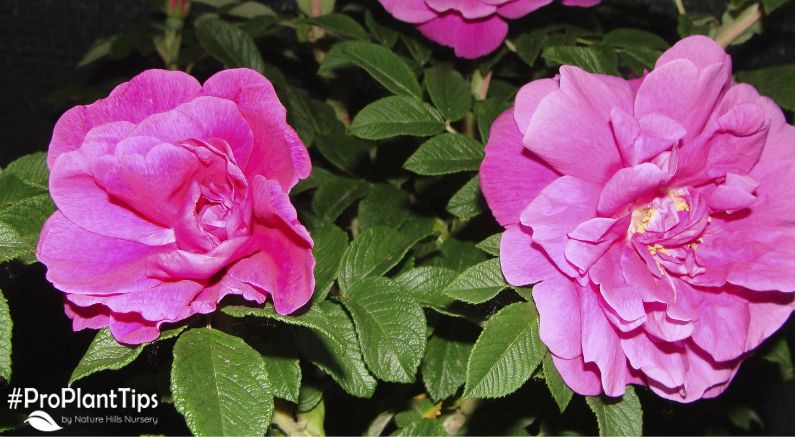
Big, colorful, flouncy petals and incredible fragrance, the hardy Beach Rose (Rosa rugosa) is widely regarded as one of many gardeners' favorite landscaping Rose bushes! Butterflies, birds, and other pollinators love rugged Rugosa Roses for their fragrance, size, sturdy growth, large, fluttering petals, and ornamental Rose Hips! That's what sets the disease-resistant Rugosa apart from the rest!
Key Features:
- Heavily veined, wrinkled leaves (hence "rugose" meaning wrinkled)
- Common names: Beach Rose, Sea Tomato, Salt Spray Rose, Sea Rose
- Drought-tolerant with excellent salt spray tolerance
- Originated in eastern Asia (China, Japan, Korea)
- Introduced to North America in the 1700s - 1800s
Let's dive into learning more about these gorgeous cold-hardy garden additions!
- The Prettiest Beach Bum!
- Our Favorite Rugosa Rose Varieties At Nature Hills Nursery
- Caring For Rugosa Roses - Complete Growing Guide
- Get Hip To Rugosa Beach Roses At Nature Hills Nursery!
The Prettiest Beach Bum!

Extremely cold-hardy perennials, Rugosa Roses, are as tough as they are pretty, with some varieties handling down to USDA growing zones 2 and 3, but handling up to zones 7 to 9 heat and humidity!
Rugosa Rose Benefits:
- Wide variety of flower colors: pink, red, purple, white, and yellow
- Single and double-flowering varieties are perfect for cottage gardens
- Continuous bloom from early summer through fall frost
- Incredibly fragrant flowers with a sweet Rose scent
- Ideal for cut flower bouquets - just wear gloves!
- Golden anthers provide an additional showy accent
- Attracts bees, butterflies, and beneficial pollinators
- Colorful Rose Hips, rich in vitamin C, provide fall/winter interest
- Fantastic fall foliage colors in yellow, bronze, and orange hues
Our Favorite Rugosa Rose Varieties At Nature Hills Nursery

Popular Rugosa Rose Cultivars:
- Blanc Double de Coubert Rugosa Rose: Most fragrant variety with semi-to-fully double white blooms
- Pink Rugosa Rose: Traditional wild Rose look with single-petalled hot pink blooms, hardy zones 3-9
- White Rugosa: Brilliant white blooms, cold-hardy to zone 2, classic English Rose scent
- Hansa Hybrid Rugosa Rose: Double, deep pink, romantic ruffled blooms with sweet-spicy fragrance
- F. J. Grootendorst Hybrid Rugosa Rose: Compact 3-4 foot size with serrated-edge blooms
- Therese Bugnet Rugosa Rose: Canadian variety, highly fragrant, blooms range from red-violet to pale pink
- Belle Poitevine Rugosa Rose: Soft magenta blush double blooms up to 4 inches across, orange-red fall hips
- Topaz Jewel Rugosa Rose: Soft topaz yellow double blooms that fade to white, no Rose hips
Rugosa Beach Roses In The Garden Landscape

These beautiful native plants require no special care, but add so much to a naturalistic garden landscape as flowering workhorses and natural focal points! Rugosa Rose shrubs are widely used in landscape design because they are tough, drought-resistant, and trouble-free!
Landscape Uses:
- Privacy hedges and natural snow barriers
- Security barrier planting (thorny canes deter intruders)
- Salt-tolerant roadside plantings and coastal gardens
- Beachfront property screening
- Cottage gardens and Rock gardens
- Foundation plantings and driveway circles
- Erosion control on slopes and hillsides
- Wildlife habitat and shelter
- Mass plantings and property division
Growing Conditions:
- Tolerates poor soil, sandy soil, and clay soils
- Drought-resistant once established
- Wind resistant
- Deer resistant due to thorny branches
- Can sucker and naturalize into thickets
Healthy Rose Hips for Foraging and Wildlife

Rose Hips are beneficial for birds, showy in dried floral arrangements, and fantastic for human consumption!
Rose Hip Benefits:
- High Vitamin C content (higher than oranges!)
- Rich in antioxidants and anti-inflammatory properties
- Can be eaten fresh (sour-tasting, cherry-tomato-sized)
- Perfect for homemade jams, jellies, and herbal tea
- Used in Rose Water production and natural skincare
- Excellent dried for floral arrangements
- Important winter food source for birds
Caring For Rugosa Roses - Complete Growing Guide

Growing Requirements:
- USDA zones 3-8 (excellent cold tolerance, virtually pest-free)
- Full sun exposure (at least 6 hours daily)
- Well-drained soil, pH 5.6-6.5 preferred
- Tolerates poor soil conditions and heavy clay
- Very forgiving for busy and new gardeners
Pruning Rugosa Roses:
- For 2-3 foot shrubs: Prune almost to ground level in early spring
- For 3-5 foot shrubs: Renewal prune the oldest canes, leave the younger canes
- Remove suckers in early spring for a tidier appearance
- No deadheading needed - removes showy Rose hips!
Winter Care:
- Wait until leaves fall, then rake away from the plant
- Mound clean leaves, mulch, or compost around the base
- In harsh climates, create a chicken wire cage filled with leaves
- Read more about caring for Roses in the winter in our Garden Blog!
Read more about winterizing Roses and unwintering Roses in our Garden Blog! Read more about caring for Roses in the winter in our Garden Blog!
Get Hip To Rugosa Beach Roses At Nature Hills Nursery!
With everything you love about Roses on a grand scale, the showy and fragrant Rugosa Rose varieties never let you down! Find out just how rewarding and easy it is to grow these garden beauties by checking out all the Rugosa Roses available at Nature Hills today!
Happy Planting!


